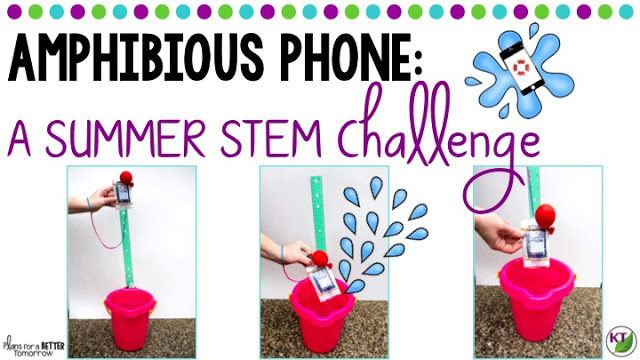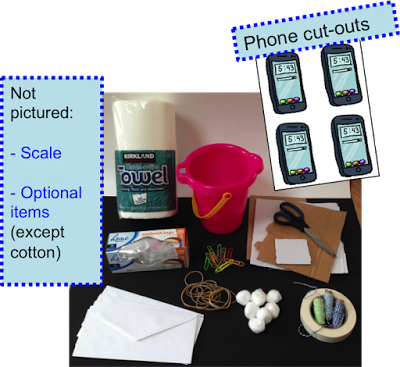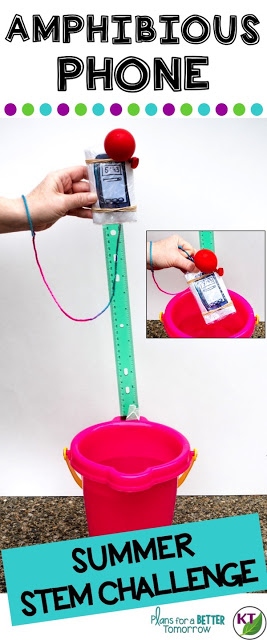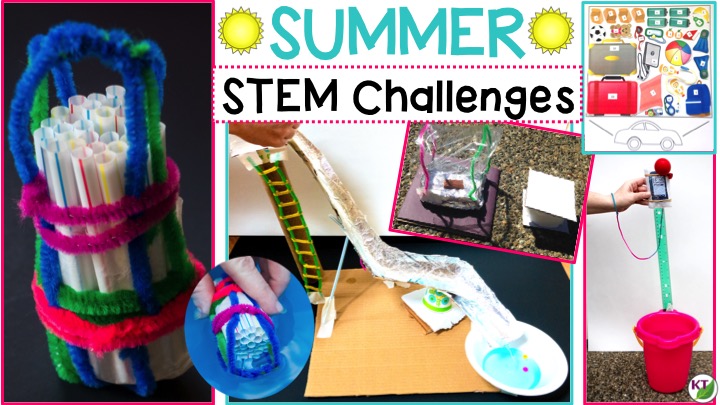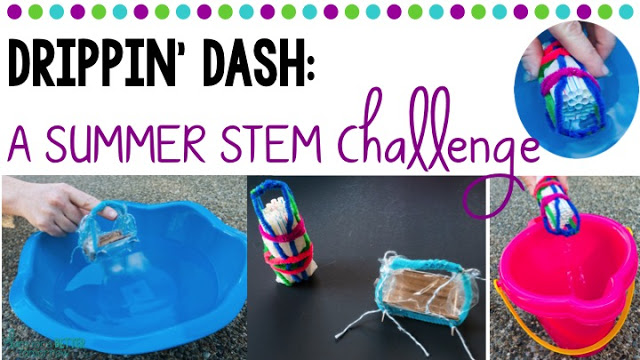Premise
Where Can I Find Out More?
If you’re familiar with my work, you know I’ve been switching over to using video to explain the bulk of my challenges. It seems to be the best/fastest way to explain the important details: materials, set-up, tips, modifications, extensions, demonstrations, and more! Who has time to read all that?! However, if you prefer to read, you’ll find the video transcribed at the end of this post.
Are There Other Summer STEM Challenges Like This?
Please reach out with any questions and tag me in photos of your students’ work on Facebook & Instagram.
PIN ME
Video Transcription of Summer STEM Challenge: Amphibious Phone
one, students are trying to design a summer-proof case that allows the phone to
live in land and on water. Don’t worry, we’re not going to use a real
smartphone. Let’s take just a second to check out the materials and the STEM
Challenge Cycle. This is the STEM Challenge Cycle you should follow for every
challenge. I’ve defined each step in another video. I’ve added a pop-in card to
that video here, as well as a link in the description.
0:33
A few quick notes about the materials. First of all, do not give your students Ziploc
bags. That makes this challenge far too easy. Instead, you can get the fold
over bags, and I actually usually like to cut them along the seams. That does
take a little bit of extra prep work, but I just usually do that while I’m
watching TV the night before the challenge. You could also just use plastic
wrap.
0:49
need to weigh down their design around that amount. If you don’t have a class
set of weights, you can use paper clips, pennies, nickels, a combination of
change, or even bread. You’ll have students place weights in an envelope, and
then you can simply have them fold it into a rectangular shape like the phone,
and then you’ll just put the cutout of the phone right on the front. If you
don’t own the Amphibious Phone resource, you can just look up smartphone clip
art online, or you could even have students draw their phone.
1:17
of kinds of tape, duct, shipping, scotch, and masking. Once the weighted phone
is ready, before the students start designing the cases, it’s helpful to have
them use some water-based markers to just make some markings around the front
and the back. When they do their waterproof testing, it makes it a lot easier
to tell if there was a leak, because those marker colors will run.
1:49
they want the phone to be retrievable if dropped into a body of water. I also
add a criterion that the screen of the phone must be visible. For younger
students, I say the case has to remain waterproof for 5 seconds. For older students,
I would increase that to 10, 15, 30. You make the call. For constraints, of
course you have time and materials. In addition, the phone needs to weigh
between 4 and 6 ounces. With the case, it should weigh no more than 8 ounces,
but if you don’t have a scale in your classroom, I would just remove the weight
constraint.
2:22
a pocket. You can require that the phone case be reusable. That is, that you
should be able to test it, take it out of its case, and use the same case again
for a second test. As I said before, you can increase the amount of time that
the phone will spend in the water and has to remain waterproof. You can require
students figure out on their own how to weigh down the phone 4 to 6 ounces,
without giving them easy materials to do so, or you could give them a mass of
paperclips but tell them the amount that they use has to keep the phone within
4 to 6 ounces, but the number of paperclips must also be divisible by 2, 3, and
4.
2:59
yes or no, and whether or not the case was waterproof, yes or no. You’ll want
to do your testing outside because there is going to be some water splash. That’s
because students are not going to gently place the phone inside the bucket.
That wouldn’t be terribly realistic. Instead, you’re going to have them do a
drop from at least a foot. Whatever the distance is that you want to use, just
make sure that you either draw or tape a line on the wall behind it, or do as I
did and tape a ruler above it.
3:25
and constraints, students will remove it, dry it off with some paper towels,
and carefully remove the phone from its case. They’ll check carefully to see if
there’s been any color run in the markers, and if they can see any evidence of
any leaks.
3:43
do touch screens even work? How do text messages work? How does your phone
always know exactly where you are? You could also have them look into why water
ruins electronics. Ask students if water is a conductor or an insulator. It’s
kind of a trick question, and maybe you even tell them it’s kind of a trick
question and have them report back to you on why.
4:06
Phone. You can follow up by having students do some research on other classes
of animal, and then see if they can come up with a challenge for another class.
They’ll do this by identifying unique factors of those classes of animal. For
example, fish can breathe underwater, but what would that mean for a phone, if
a phone could breathe underwater? Maybe they’ll interpret it to mean the phone
has to be able to be powered underwater, or powered from water. You can allow
them to choose just one class or try to come up with a challenge for every
class. You could simplify that and simply have the students do more of an art
activity where they create designer phone cases for each class of animal.
4:44
short story about the day the smartphones arrived under the sea. It’s great for
personification and characterization, and I like to also have students
brainstorm ahead of time what the different reactions of the sea creatures
might be to the smartphones’ arrival. You might have acceptance, reverence,
fear, distrust. Have the students write their stories collaboratively, and you
can either let them choose one of the reactions, or assign different reactions
to every group and then compare how different the stories are at the end.
5:15
as always, this resource is packed full of goodness for you, so take a second
to check it out. This time saving resource contains everything you need,
including modifications for use with second through eighth graders. You’ll
still need to gather the simple materials, of course, but the rest is ready and
waiting. You’ll get Aligned Next Generation Science Standards, links to my STEM
Challenge How-to videos to help you get the most from each challenge, the
Amphibious Phone Materials list.
5:39
difficulty through the Criteria and Constraints list, measuring results, and
cross-curricular extension suggestions. You’ll find an editable Criteria and Constraints
list so you can tailor the challenge to your students. You’ll also receive
smartphone templates. There are two versions of design analysis handouts, four-page
expanded room for response for younger students, and a two-page condensed space
paper saver version.
6:02
you’ll find an animal classes activity. You’ll also receive an under the sea
writing prompt with handouts, as well as math extension and process flow
templates. This resource is available individually and as part of the
discounted Summer and Mega STEM Challenge bundles. Links can be found in the
description below the video.
following my store on Teachers Pay Teachers or subscribed on YouTube. Have a
fabulous week. I’ll see you next time.

